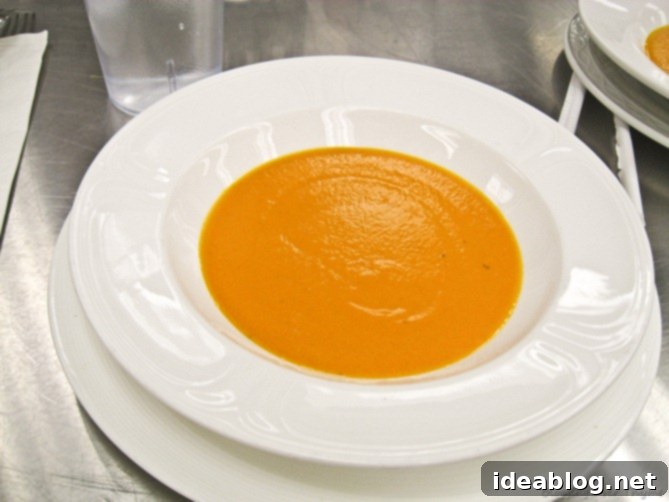A Culinary School Week: Mastering Classic French Techniques from Amandes to Artichokes
This past Monday unfolded as a remarkably smooth and productive day in the kitchen, despite one minor mishap – accidentally leaving my indispensable notebook at school! It’s always a welcome relief to glimpse a manageable menu sketched on the whiteboard at the start of the day. Yet, this feeling of ease often comes with a touch of nervous anticipation, as my mind inevitably races ahead, wondering what exciting and challenging culinary adventures the next day’s curriculum will bring. Each class builds upon the last, deepening our understanding of fundamental principles and expanding our practical skills, making every new menu a blend of familiar comfort and fresh discovery.
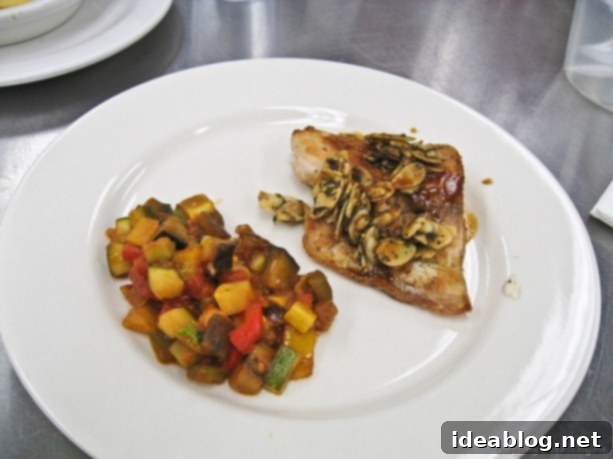
Exploring Meunière Variations: Tilapia Amandes
Our recent culinary session seamlessly blended the introduction of new techniques with a valuable opportunity to revisit and refine some established methods. The centerpiece of our lunch service was a delightful fish dish, showcasing yet another exquisite variation of the classic French meunière sauce. For those unfamiliar, meunière is a foundational pan sauce, traditionally crafted from whole butter lightly browned to a nutty aroma, brightened with finely chopped fresh parsley, and finished with a zesty squeeze of lemon juice. It’s a testament to simplicity yielding profound flavor, often served with delicate pan-fried fish. The name itself, “meunière,” translates to “miller’s wife,” referring to the traditional dredging of fish in flour before cooking.
In previous classes, we’ve explored derivatives like grenobloise, which elevates the meunière profile with the intriguing additions of briny capers and crisp, golden croutons. This constant evolution of a core sauce demonstrates the versatility and depth of French culinary principles, teaching us how subtle changes in ingredients can create entirely new sensory experiences. Understanding these “small sauces” or derivatives is a crucial part of classical training, allowing for endless creativity within established frameworks.
The particular variation we mastered on Monday was known as Amandes, distinguished by its vibrant orange hue. This preparation shares the fundamental elegance of meunière but is set apart by the generous inclusion of thinly sliced and perfectly toasted almonds. The almonds are carefully browned in the butter, imparting a beautiful golden color and a wonderful textural contrast, alongside a rich, nutty depth that complements the delicate fish beautifully. While many classical preparations often feature more robust white fish like trout or flounder, our culinary journey this time led us to work with tilapia. This choice proved to be excellent, as the mild flavor and flaky texture of the tilapia provided the perfect canvas for the vibrant Amandes sauce, allowing its nuanced flavors to truly shine.
This dish, in its various forms, has consistently ranked among my favorites in the program so far. Its harmonious blend of flavors and textures is truly satisfying, and I was genuinely pleased to see it on the menu once more, offering another chance to refine my execution. I’m eagerly anticipating the opportunity to recreate it in my home kitchen, perhaps even experimenting with different fish. However, a significant hurdle remains: mastering the art of making a proper demi-glace. This rich, concentrated brown stock forms the backbone of many classical sauces and remains a challenging, albeit rewarding, endeavor to perfect outside of a professional kitchen environment due to its time-intensive nature and precise technique. It represents a commitment to deep flavor that truly elevates a dish.
Rustic Ratatouille: A Harmonious Accompaniment for School Events
Accompanying our delicious tilapia, we proudly served a vibrant batch of ratatouille, a beloved Provençal stew that we had learned to prepare for the first time just last week. This flavorful medley of summer vegetables—eggplant, zucchini, bell peppers, tomatoes, and onions, all simmered with garlic and herbs—is a true classic. Our chef specifically requested a more rustic variation for this batch, emphasizing heartier cuts and a generous quantity. This wasn’t merely for our immediate lunch service; the substantial leftovers are earmarked for two important upcoming events. Firstly, they will be utilized for the school’s open house this Saturday, where prospective students and guests will be treated to a delicious and authentic lunch. Secondly, they will provide a crucial component for a required make-up day for us students, ensuring consistency and quality across multiple culinary engagements. The rustic style meant less fuss over perfect dicing and more focus on robust flavors, perfect for a larger catering scenario.
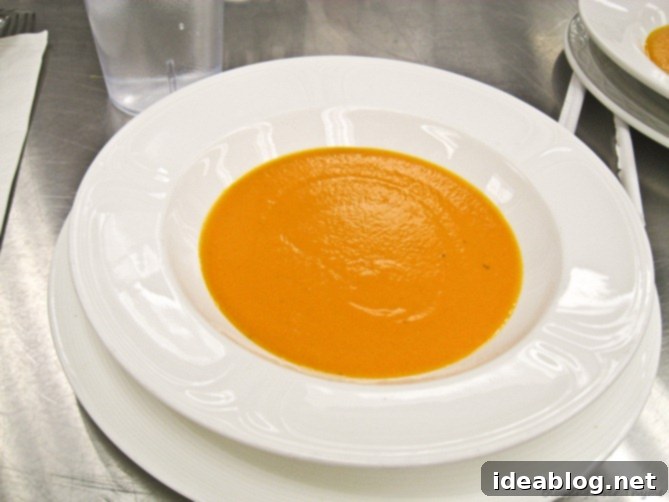
The Aromatic Warmth of Potage Crécy: A Ginger-Infused Carrot Delight
Beyond the main course, we also introduced a new and exceptionally comforting soup: Potage Crécy. In our curriculum, a “potage” refers to a refined, often puréed soup, typically initiated with a base of gently sautéed leeks, which provides a sweet and aromatic foundation without overpowering other ingredients. We’ve already explored several different styles of potages, each offering unique flavor profiles and textures, from creamy vegetable purées to lighter broths. However, the Potage Crécy instantly claimed its spot as my personal favorite among them all, captivating me with its unique spice blend.
As its beautiful, vibrant orange hue might suggest, Potage Crécy is a sophisticated carrot soup, named after Crécy, a region in France renowned for its carrots. What truly set this particular recipe apart was the masterful and multi-faceted incorporation of ginger. Not just one form, but a fascinating trio: finely ground ginger for a foundational warmth, fresh grated ginger for a bright, pungent kick, and even small pieces of crystallized ginger, which melted slightly into the soup, offering a subtle sweetness and a delightful chewy texture. This multi-faceted approach to ginger infusion created an incredibly complex and aromatic flavor profile, offering layers of warm spice, bright freshness, and a subtle, sweet chewiness from the crystallized pieces. It was a truly inspired combination that elevated a simple carrot soup to something extraordinary, demonstrating how a single ingredient can be used in various forms to build depth.
The entire mixture was meticulously puréed in a high-speed blender, ensuring an incredibly smooth and uniform consistency, a hallmark of a refined potage. To achieve the ultimate silken texture, the soup was then carefully passed through a chinois, a fine-mesh conical sieve. This crucial step removes any last fibrous bits from the carrots or ginger, resulting in a perfectly smooth, velvety liquid that glides across the palate. Just prior to service, a small amount of rich heavy cream was stirred in, lending an additional touch of luxurious richness and a velvety mouthfeel without overpowering the delicate carrot and ginger flavors. The final result was a soup of stunning color, deceptively simple in its preparation, yet bursting with a depth of flavor that was both comforting and invigorating, perfect for a cooler day.
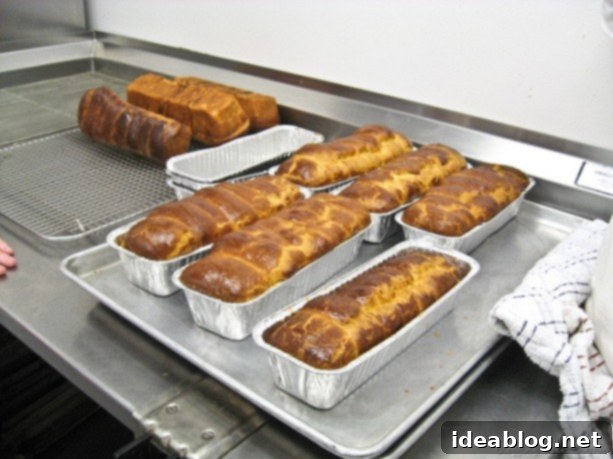
Indulgent Pain Perdu: A Brioche Bread Pudding Masterpiece
Last, but certainly not least, our dessert offering for the day was a truly indulgent creation: Pain Perdu. This translates literally to “lost bread” in French, but it’s more commonly known as French toast or, in this context, a sophisticated bread pudding. This wasn’t just any ordinary bread pudding; it was a masterpiece crafted from leftover brioche bread – the very same rich, buttery, and slightly sweet bread that we had painstakingly learned to make in a previous session. The effort put into mastering brioche production truly paid dividends in this delightful dessert, proving that even “lost bread” can be transformed into something extraordinary.
At its core, Pain Perdu involves soaking slices of day-old bread in a luscious, egg-rich custard before baking. The slightly stale brioche is ideal because it readily absorbs the custard without becoming soggy, retaining a beautiful texture. In our version, the brioche was thoroughly saturated in an incredibly decadent mixture, ensuring that every bite was moist, tender, and bursting with flavor. To elevate this already sublime dessert, we incorporated plump raisins that had been generously steeped in dark rum. The rum-soaked raisins introduced a wonderful complexity – a boozy warmth and a subtle fruitiness that complemented the sweet custard perfectly, making the dish extra special and truly memorable. The combination of rich brioche, creamy custard, and aromatic rum was a symphony of flavors.
My jaw quite literally dropped when I observed the sheer quantity of half and half (a luxurious blend that is 50% whole milk and 50% heavy cream) required for the custard – more than two cups for a single batch! It was a vivid reminder of the sheer richness inherent in classic French patisserie, where flavor and texture often take precedence over calorie counts. A fleeting thought of “Holy arteries!” crossed my mind, quickly followed by the undeniable realization that such indulgence is precisely what makes these desserts so utterly irresistible and a true treat for special occasions. It’s a lesson in embracing the luxurious side of culinary arts.
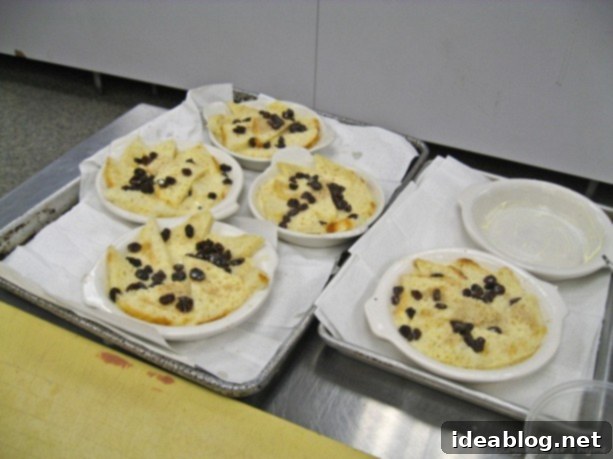
This magnificent bread pudding was then carefully placed into an oven and baked in a water bath for approximately 25 minutes. The water bath, or “bain-marie,” technique is crucial for custards and delicate preparations, as it provides gentle, even heat from all sides. This prevents the edges from overcooking and curdling while allowing the center to set slowly and smoothly, resulting in a uniformly creamy, silken texture throughout the entire pudding. It’s truly amazing to reflect upon the sheer versatility and diverse forms that can be achieved from the simple, yet magical, combination of eggs, sugar, and milk or cream. From crème brûlée to savory quiches, and from ice cream to flans, custards are a cornerstone of both sweet and savory cooking, demonstrating the incredible potential of these basic ingredients.
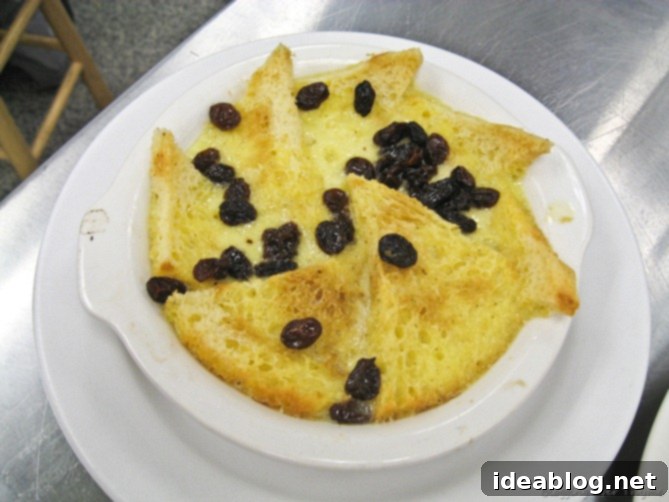
Afternoon Lessons: Mastering Artichoke Preparation
After a satisfying lunch service, our afternoon transitioned from cooking to meticulous kitchen cleaning, followed by another illuminating culinary lesson. The focus of this session was learning how to “turn” artichokes – a precise and elegant technique that involves expertly removing the fibrous outer leaves and the inedible hairy choke to reveal the tender, edible heart, preparing it impeccably for presentation and cooking. This skill is fundamental for many classical French dishes that feature artichokes as a refined component, and it requires both patience and a steady hand.
As the accompanying image clearly illustrates, the artichoke on the left remains whole and intact, showcasing its natural, somewhat intimidating form. In stark contrast, the artichoke on the right displays a perfectly “turned” heart, carefully extracted with a sharp paring knife. This process involves peeling away layers of tough outer leaves, trimming the stem, and scooping out the fuzzy choke without damaging the delicate heart. Throughout this delicate process, lemons were kept readily on hand, their acidic juice vital for rubbing over the exposed artichoke flesh. This immediate application of lemon juice prevents oxidation and the unsightly browning that occurs rapidly upon exposure to air, ensuring the hearts retain their appealing pale color. Having only ever cooked whole artichokes in the past, often by steaming or boiling them, learning this refined technique was a particularly engaging and satisfying experience, significantly expanding my repertoire of essential kitchen skills and offering a new perspective on this versatile vegetable.
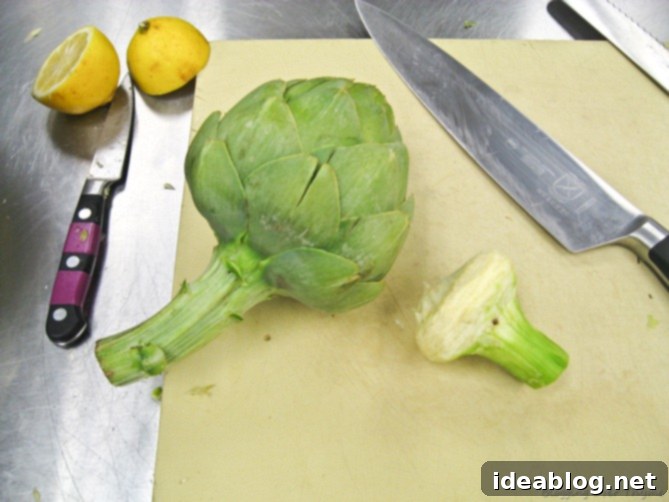
Cooking and Storing Artichoke Hearts: The Blanc Method
Once the hearts were meticulously turned, our next step was to cook them using a classic French method known as a BLANC. This technique is not only traditional for cooking artichokes but also serves as an excellent preservation method, crucial in a professional kitchen for advance preparation. A blanc is a simple yet effective poaching liquid, typically composed of water, a small amount of flour (approximately two tablespoons), and lemon juice for its crucial acidic component. The flour, when whisked into the water, creates a slightly cloudy suspension. This serves a dual purpose: firstly, it helps prevent light from directly hitting the delicate artichoke hearts, which helps to maintain their vibrant color. Secondly, in traditional culinary lore, it is believed to subtly improve and add a nuanced, almost creamy, flavor to the artichokes as they gently simmer.
The blanc works its magic by tenderizing the artichoke hearts, transforming their naturally firm texture into a beautifully yielding consistency perfect for various culinary applications, such as salads, sautés, or gratins. The acidity from the lemon also aids in this tenderization process while further inhibiting discoloration. Since our cooked artichoke hearts were destined for use the following day, we carefully stored them submerged in their blanc in the refrigerator overnight. This method ensures they remain tender, retain their pristine color, and are perfectly prepped for their next role in our menu, highlighting the efficiency and foresight required in professional cooking.
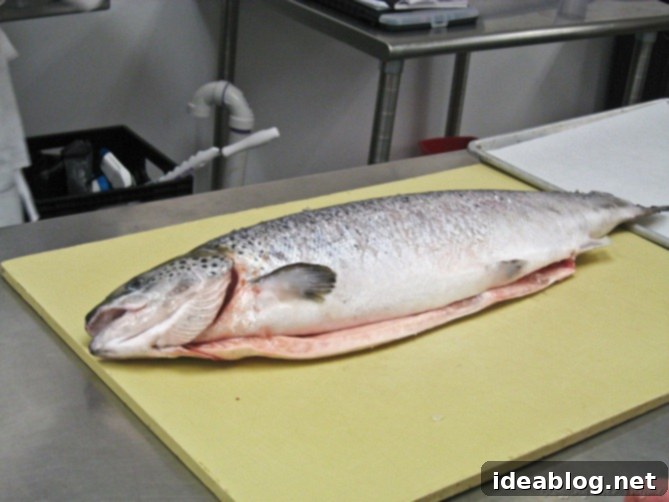
A Glimpse into the Future: Salmon Butchery and Smoking Prep
Our afternoon concluded with an invaluable demonstration by Chef Brian on the intricate process of breaking down a whole salmon. The magnificent specimen before us weighed approximately eight pounds, offering a substantial lesson in fish butchery. While this was a demonstration for now, Chef Brian informed us that in Phase II of our program, each student will have the opportunity – and the requirement – to break down an entire salmon independently. This foresight into future challenges highlights the comprehensive nature of our culinary training, preparing us for increasingly complex tasks and building confidence in our knife skills and understanding of proteins.
Witnessing the chef deftly navigate the fish, transforming a whole creature into pristine fillets with remarkable speed and precision, was genuinely captivating. It’s a skill that requires not just a sharp knife, but also a deep knowledge of fish anatomy and an understanding of how to minimize waste. Interestingly, unlike the bones from flounder or other white fish, salmon bones are generally not considered suitable or saved for making culinary stock due to their strong, oily flavor profile, which can be overpowering and create an undesirable, muddy taste in stock. Instead, they are typically discarded, or sometimes repurposed for specific preparations like fish fumet if handled very carefully to avoid off-flavors.
After expertly filleting the salmon, Chef Brian then meticulously prepared the fillets for their next exciting transformation. He generously rubbed them with an even mixture of coarse kosher salt and dark brown sugar. This combination serves as a crucial curing agent, drawing out moisture, enhancing flavor, and preparing the fish for its ultimate destiny: SMOKING. Yes, we are indeed going to be smoking this entire fish to serve at the upcoming open house! The prospect of enjoying freshly smoked salmon, with its rich, savory, and subtly sweet notes imparted by the cure and the smoke, is incredibly appealing. It’s a dish I particularly adore, and I’m eager to experience the results of our collective efforts in this fascinating culinary process, from raw fish to a perfectly cured and smoked delicacy.
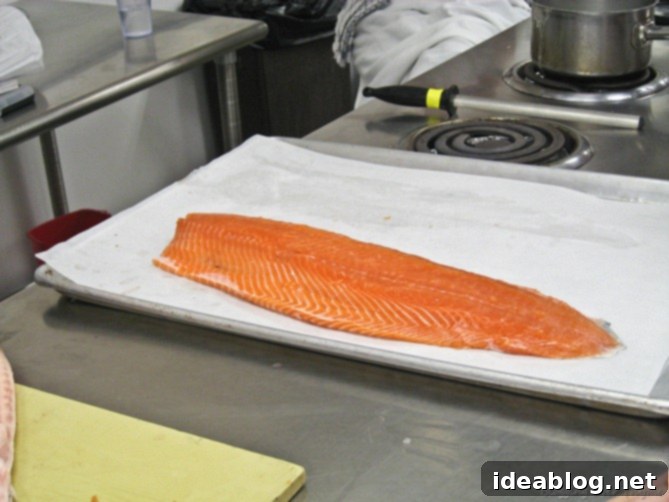
With my latest culinary paper submitted ahead of its Thursday deadline, I’m fortunate to have some breathing room before the next academic sprint. This small victory allows me to reflect on the intensive learning curve of culinary school and appreciate the diverse skills we acquire daily. I’ll be back soon with another detailed update on today’s class, sharing more insights into our ongoing journey through the demanding yet incredibly rewarding world of professional cooking. Until then, I hope you all enjoyed a wonderful weekend, perhaps filled with delicious food and good company, and a very Happy Valentine’s Day!
